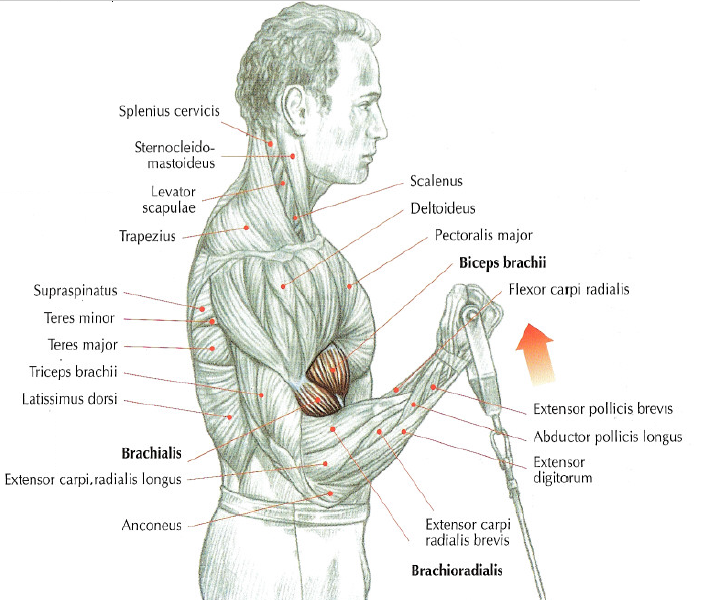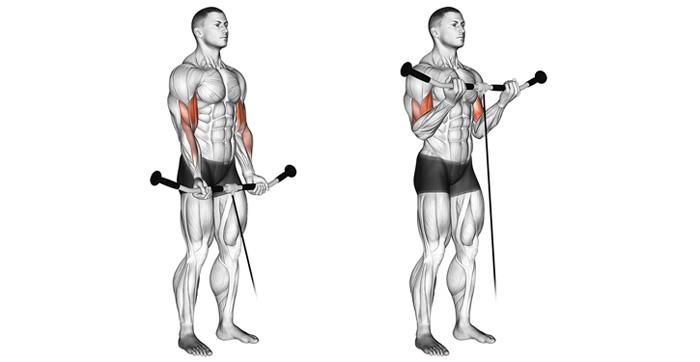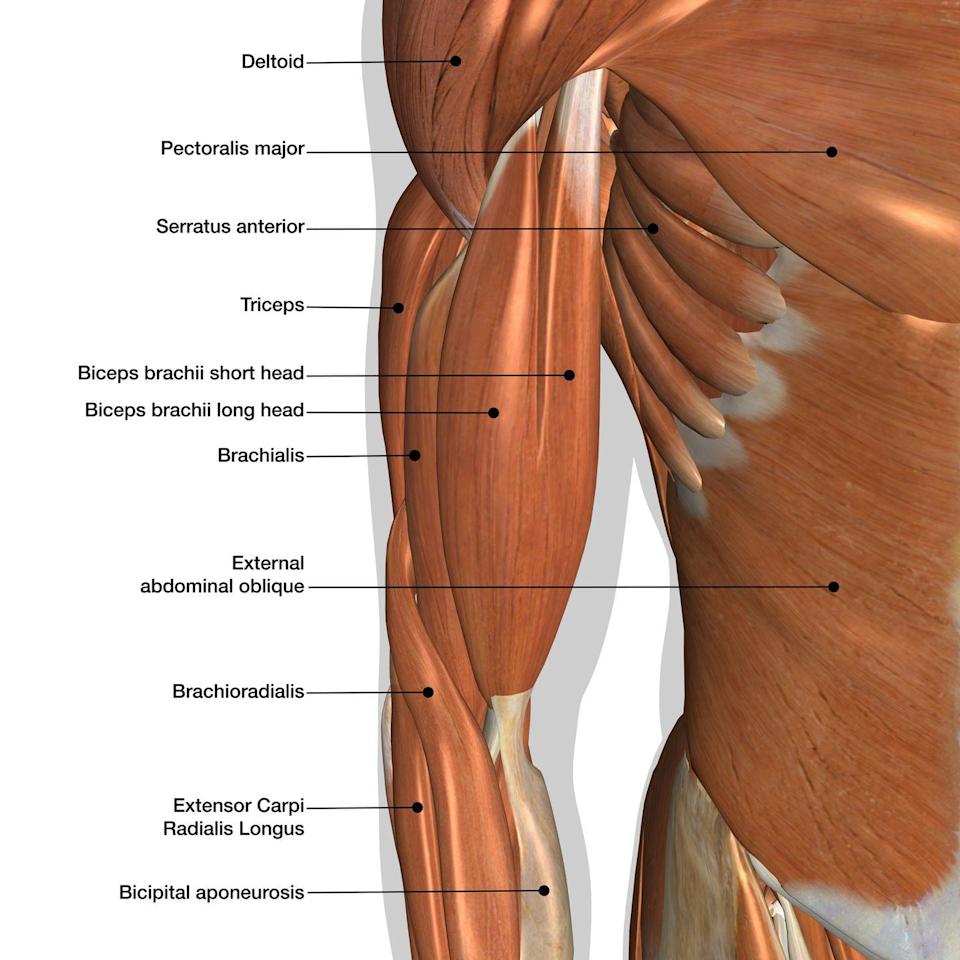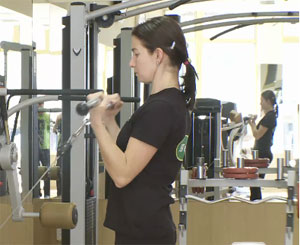
Biceps flexion of the lower pulley is a pulling exercise with an isolating character. Offers the ability to perform in multiple positions and with different handles and grips. It can be included in programs for beginners, intermediate and advanced fitness or bodybuilding enthusiasts.
What’s more, women and professional athletes love it. The first because of the easy and comfortable performance, and the second – because of the huge variety of possibilities for playing with the points of maximum muscle tension.
Contraindications
Trainers with injuries to the elbow joints, shoulders, shoulder girdle, wrists or forearm muscles should be careful when performing it. Performing with great weight in an upright position transfers the load on the waist if the abdominal muscles fail in their stabilizing function. People with a problematic lower back are recommended to perform it from a seat on a bench or on the floor.
Participating muscles
Dynamists
- Biceps brachii
Synergists
- Brachialis anticus
- Brachioradialis
Extras and dynamic stabilizers
- Shoulder muscles, front heads (Deltoid, Anterior)
- Wrist flexors
- Trapezius muscles, upper and middle part (Trapezius upper and middle)
- Shoulder lifters (Levator scapulae)
- Straight abdominal muscle (Rectus abdominis), in an upright position
- Oblique abdominal muscles (Obeliques), performed with only one hand
- Long spinal muscles (Erector spinae), in a bench position or in one-sided execution with one hand
- Large gluteal muscles (Gluteus maximus), in an upright position
- Quadriceps, in an upright position
- Calves (Gastrocnemius), in an upright position, when performed from a floor seat
- Large pectoral muscles (Pectoralis major), performed with only one hand
Folding according to body position
- From a standing position – the most popular, this option has a point of maximum flexion at the end of the amplitude.
- From a bench seat – here the peak flexion occurs in the middle of the amplitude, and at its end there is a point of load drop.
- From a seat on the floor – the peak flexion is in the first third of the amplitude.
- From squats with elbows resting on the knees – the place of peak flexion can be changed according to the height of the elbows and the distance from the reel. Leaning on the elbows eliminates the possibility of overcoming the critical point with shoulder rotation and elbow displacement.
Folding according to the type of grip, the width of the grip and the handle
- With a grip – loads the forearms, a slight emphasis on the inner heads.
- With a semi-approach – power grip, includes more brachialis.
- With a parallel grip – force grip, includes largely brachialis and brachioradialists.
- With a narrow grip – the elbows are wider than the wrists, the emphasis is on the outer heads.
- With shoulder grip – with elbows and wrists in one width, this is the ideal width for strength performances. There is no specific emphasis, the load is evenly distributed.
- With a wide grip – the elbows are deeper than the wrists. Clear emphasis on the inner heads.
- With dynamic grip – many different combinations are possible. We will consider specific options in the future in separate articles.

According to the sequence of execution
- Unilateral – a series with only one hand, after which a series is made with the other. Allows for better accentuation and for power balance left / right hand.
- Bilateral, at the same time – the most widely used option. Enables strength performance, covers the power imbalance of the left / right biceps, equating the flexion force to the weaker muscle.
- Bilaterally, consistently – allows for longer series, stimulates to improve strength endurance. Provides an opportunity to check the strength and endurance between the left and right biceps.
Biceps flexion of the lower pulley from an upright position
Preparation and implementation
- Choose a weight, choose a grip and a handle.
- Take the handle and take the starting position – upright, with a tight torso and arms relaxed to the body.
- Slowly bend your arms without moving your elbows away from your body and without moving your arms back and forth.
- After fully folding your arms, slowly return the handle to its original position.
- Repeat until the end of the series, then squat and leave the handle on the floor.
Recommendations
- Keep your elbows still during the exercise.
- Keep your body still during the exercise. Do not swing, do not bend over. Move only in the elbows – the other joints should be immobile.
- If you notice that you are bending your spine back when lifting, try to perform the exercise slightly bent forward and with a tight abdomen, without relaxing it until the end of the series.
- Do not start the exercise with heavy weights without warming up well. Make your first set lighter and more repetitive to move your biceps and joints. Only then increase the weight.
The exercise is suitable for performance by fitness trainers, fitness trainers and bodybuilding amateurs regardless of their training experience. It is easy to perform and has a low risk of injury.
Biceps flexion of the lower pulley is included in fitness and bodybuilding splits as the first, second or third exercise for the biceps. Usually its place is determined by the specifics of the program. You can include it in strength and mass schemes according to your experience as a third or last exercise, as long as your program provides a large number of series.
In shaping, endurance, or strength endurance programs, the biceps flexion of the lower pulley sometimes displaces even the dumbbells in order of execution. The choice here is individual.
In tone and fitness programs, lowering the lower pulley can be the first and only exercise for the biceps, especially if the performer has joint problems when bending with free weights (dumbbells, levers).


